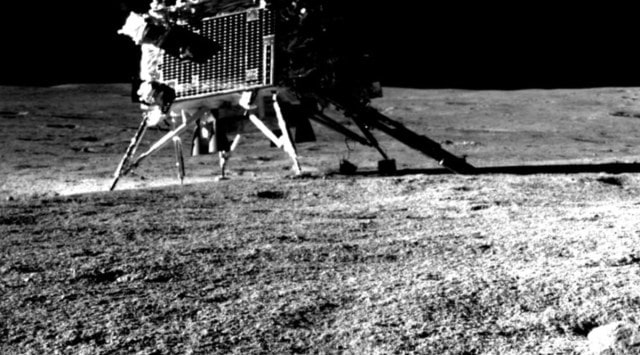Smile, please! ISRO shares image of Chandrayaan-3 lander Vikram captured by Pragyan rover
The update from the Chandrayaan-3 mission came at a time when the rover has reached nearly half of its state life of one lunar day, equivalent to 14 days on Earth.
 On August 23, India created history after Chandrayaan-3 made it the first country to have a soft landing near the lunar south pole. (Image: ISRO)
On August 23, India created history after Chandrayaan-3 made it the first country to have a soft landing near the lunar south pole. (Image: ISRO) The Pragyan rover Wednesday morning clicked a photograph of the Vikram lander with the help of its navigation camera, the Indian Space Research Organisation (ISRO) said in a tweet along with the caption “Smile, please!”.
Sharing the photographs through its official handle on X (formerly Twitter), ISRO said, “Pragyan Rover clicked an image of Vikram Lander this morning. The ‘image of the mission’ was taken by the Navigation Camera onboard the Rover (NavCam).”
Chandrayaan-3 Mission:
Smile, please📸!
Pragyan Rover clicked an image of Vikram Lander this morning.
The 'image of the mission' was taken by the Navigation Camera onboard the Rover (NavCam).
NavCams for the Chandrayaan-3 Mission are developed by the Laboratory for… pic.twitter.com/Oece2bi6zE
— ISRO (@isro) August 30, 2023
The update from the Chandrayaan-3 mission came at a time when the rover has reached nearly half of its state life of one lunar day, equivalent to 14 days on Earth. The lander and the rover are unlikely to survive beyond the lunar day as temperatures plummet to -130°C in the absence of sunlight.
The rover has been moving on the lunar surface, finding craters and determining the elemental composition of the Moon.
One of the instruments onboard the mission on Tuesday conducted the first analysis of the elements near the Moon’s South pole. This confirmed, “unambiguously”, the presence of sulphur in the region. The analysis also revealed the presence of other elements such as aluminium, calcium, iron, chromium, titanium, manganese, silicon and oxygen. The experiment is still searching for hydrogen.
Such observations are not possible from orbiters going around the moon, including the Chandrayaan 2.
The Laser-Induced Breakdown Spectroscopy (LIBS) can detect the elements present regardless of the state they are in. It can carry out multi-element rapid detection that can help in quickly studying the elemental composition given the time constraint of fourteen days, the ISRO said.
The rover on Sunday had also encountered a four-metre-wide crater in its path. It was then commanded to retrace its path and move on to a new one. The tracks left by the six-wheeled rover were then captured by its navigational camera.
Notably, the ISRO is preparing to undertake another big-ticket mission — Aditya L1. The rehearsal for the mission and internal checks of the vehicle are completed for the launch, scheduled for Saturday at 11.50 am from Sriharikota.
The mission will carry out seven scientific experiments, 1.5 million kilometre away from the Earth, to look directly towards the Sun and study its various atmospheric layers and explosive phenomena. The journey to the L1 point will take nearly four months.







